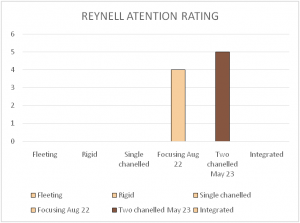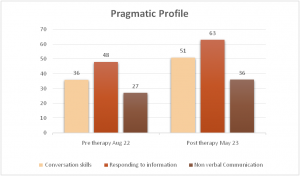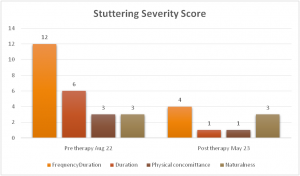
Autism and Stuttering- Case study
Autism and Stuttering- Case study
This article helps you to understand the clinical insights of a child with Autism and stuttering. Autism also called Autism Spectrum Disorder is a neurological condition with deficits in social interaction, communication, and repetitive behaviors. Stuttering is a fluency disorder characterized by repetition of sounds, syllables/ words, prolongation of sounds, and interruptions in speech. There is less data reported about the frequency of stuttering among individuals with ASD.
There is a steadily expanding amount of research on stuttering in children with ASD. A dual diagnosis of Autism and stuttering has been reported earlier. Here are a few studies that help us to know the connection between these two.
Recently, children with ASD were identified to have stuttering, cluttering, excessive non-stuttering-like disfluencies, and atypical disfluencies. These include final word repetitions and prolongations. According to studies published by Kathleen Scaler Scott (2013), stuttering-like disfluencies are common in children with Asperger’s Syndrome. Shriberg et.al, (2001) states that 67 out of 100 males with Asperger’s syndrome exhibit dis-fluent speech compared to 40 out of 100 with high-functioning ASD.
The purpose of the present study was to document and discuss the tele-speech treatment of a child with Autism and stuttering
Case study of the child’s Assessment and Treatment of Autism and Stuttering-
Participant
A 9-year-old boy diagnosed with “Spoken language disorder secondary to ASD and mild stuttering” was considered for this case study.
Background information
Initially, the child has been diagnosed to have ASD at 18 months of age, as reported by the parents. Since then, he is receiving ABA, Occupational therapy, and speech therapy services. The child is studying 4th grade in regular school. He performs well in academics. However, his social skills with peer kids are not age appropriate. A family history of stuttering is reported, the child’s father has had mild stuttering since childhood.
Method
Participant underwent a detailed speech and language assessment on 16th August 2022.
The tests administered were Clinical Evaluation of Language Fundamentals-5 to assess his social skills, Reynell Scale of Attention to assess his attention skills, and Stuttering Severity Index SSI-4 to assess his fluency skills.
The results after the assessment of Autism and Stuttering were as follows
1. CELF-5 Pragmatic profile:
The child has difficulty participating in conversations, responding to information, and nonverbal communication skills. His pragmatic profile score was 111 out of 200 points.
2. Reynell scale of Attention:
The child scored four on a six-point rating scale in attention. This indicates that the child is gradually beginning to control his own focus of attention but can still focus on one thing at a time. However, he can now shift his focus of attention from one to the other.
3. SSI- Stuttering Severity Index-4
Including spontaneous speech and reading samples. The scores were – Frequency: 12, Duration: 6, Physical Concomitants score: 3, and Naturalness of Speech: 3.
A diagnosis of Autism Spectrum Disorder with mild Stuttering has been made upon detailed evaluation and testing.
Speech and language therapy of Autism spectrum disorder and stuttering.
After the detailed evaluation, the participant was advised to undergo speech therapy sessions for overall speech and language improvement. The participant enrolled to receive online speech therapy once a week for ten months from August 2022 to May 2022. The participant also enrolled in group therapy from February 2023 to May 2023 to generalize the goals with a peer group.
Firstly, the treatment focused on improving his attention and listening using active listening strategies and a whole-body listening approach. Secondly, to improve his social and communication skills like problem-solving behavior, inference skills, turn-taking, topic initiating, and topic maintenance skills, we used a pragmatic approach and compensatory strategies. Thirdly, breathing exercises and Stuttering analogies were used to reduce the stuttered speech.
Results
A pre-therapy and post-therapy assessment was done to determine the progress. The child showed steady improvement in all three target areas.
Graph 1 shows pre and post-therapy scores of the child’s attention level.
The child’s attention level was scored 4 on a 6-point rating scale in August 2022 and post-therapy his attention improved and rated as 5, i.e. the child can do a task and understand an instruction at the same time. His concentration span is still short but he can attend a small group and instructions.
Graph 2 shows the pre and post-therapy scores of social and communication skills- Pragmatic profile.
At first, the child’s social communication skills on the pragmatic profile were rated as 111/200. Then post-therapy the child showed a significant improvement in conversation skills and responding to information. Later, his score improved to 150/200.
Graph 3 Pre and Post therapy scores of frequency, duration, physical concomitant, and naturalness rating.
The child’s results showed a significant improvement besides his stuttering score reduced. The post-therapy scores are within very mild severity on Stuttering Severity Index-4. Stuttering disruptions such as repetitions, hesitations, and prolongations were reduced post-therapy.
Discussion and Conclusion:
To conclude, it is important to screen for fluency disorders in ASD children as stuttering impacts their communication and social skills. Hence, speech therapy is crucial for children with ASD to improve their speech and communication skills. The results of the present study indicate positive progress in the overall speech fluency and social skills of the child.
Research articles related to stuttering and autism.
-
Stuttering and Autism Spectrum Disorders: Assessment and Treatment. https://pubmed.ncbi.nlm.nih.gov/35697034/
Click here to read more case studies
- Autism and Stuttering- Case study - June 16, 2023
- Speech Tips for Fragile X Syndrome - November 29, 2021
- Choosing the Best Therapist for Your Child - October 12, 2021




Leave a Comment
(0 Comments)